We have looked at one of Adolf Furrer’s M1919 submachine guns before, but this one is a much different implementation. The model 1919 Furrer designed was basically a chassis for converting a Luger pistol into a carbine. He lengthened the barrel, added a booster to help it cycle, and replace the gripframe with a magazine well for a subgun-type magazine. The one previously featured here was fitted to a wood stock to use as a shoulder weapon, but this one is a double-barrel design intended to be fired from a mount.
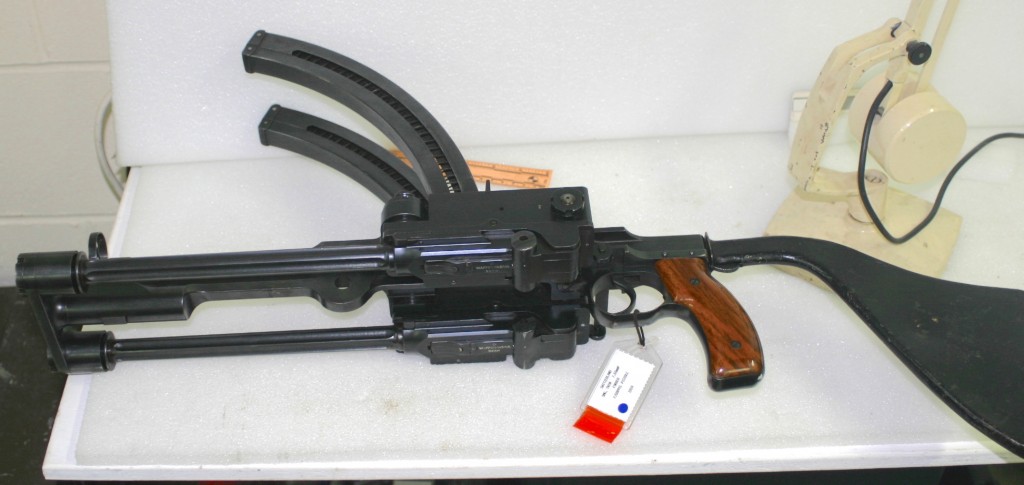
This example (bearing serial number 1, incidentally) has a very solid mounting point located between the barrels just ahead of the chambers and a pistol grip with detachable shoulder stock. It does not have much in the way of a convenient place to hold the front of the weapon, further suggesting that it was intended to be fired mounted. This type of application in 1919 could have been useful as an observer’s gun on an aircraft or mounted to a ground vehicle.
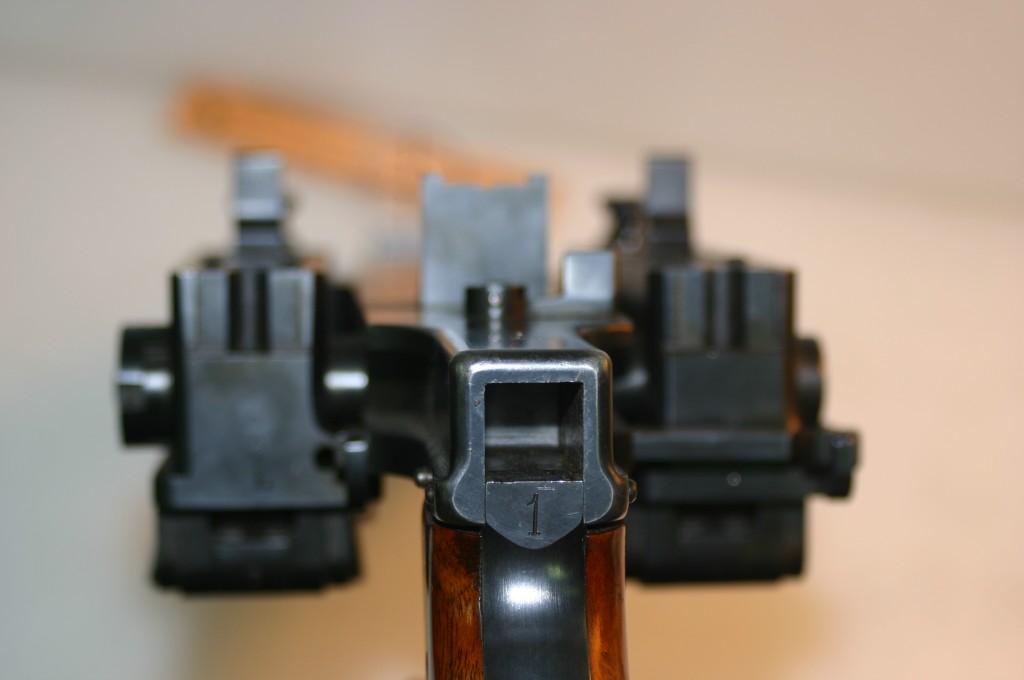
It uses two curved magazines of unknown capacity (probably 40 rounds, I would guess), and is chambered for the 7.65mm Parabellum cartridge. Where the single-barrel shoulder rifle Furrer mounted the Luger action with the toggle to one side, this design has the toggle actions mounted facing downwards. This would probably be a fairly convenient arrangement for controlling ejecting brass, and it also makes the magazines easy accessible atop the weapon.
I have not found much other information about this design – it was not adopted, and probably not manufactured in any significant quantity. Furrer would go on to develop the Swiss LMG-25 a few years later, which was more successful (and also a toggle locking system).
Thanks to the National Firearms Centre in Leeds, we have a whole slew more photos of the gun. I do apologize for the photo quality; these were taken a couple years ago.
Here are a few photos of the magazine specifically:



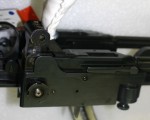
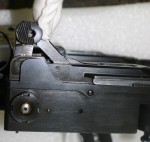

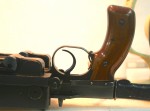







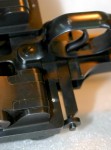
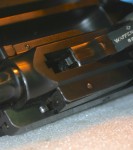










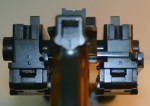





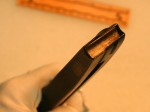


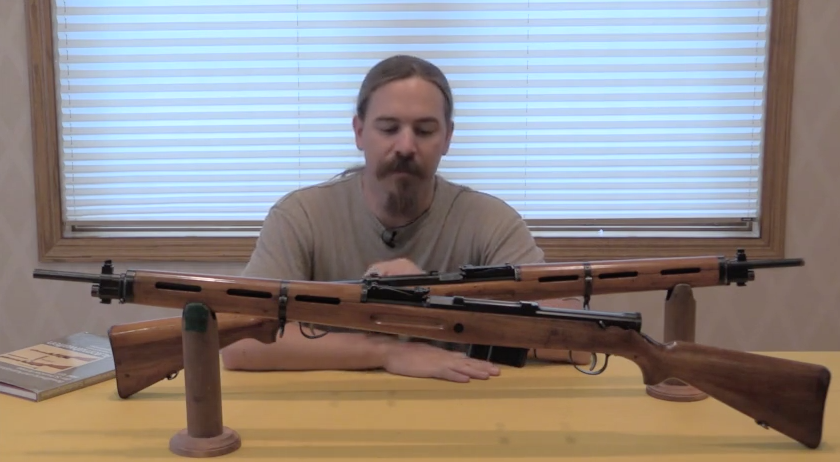
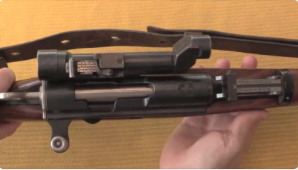
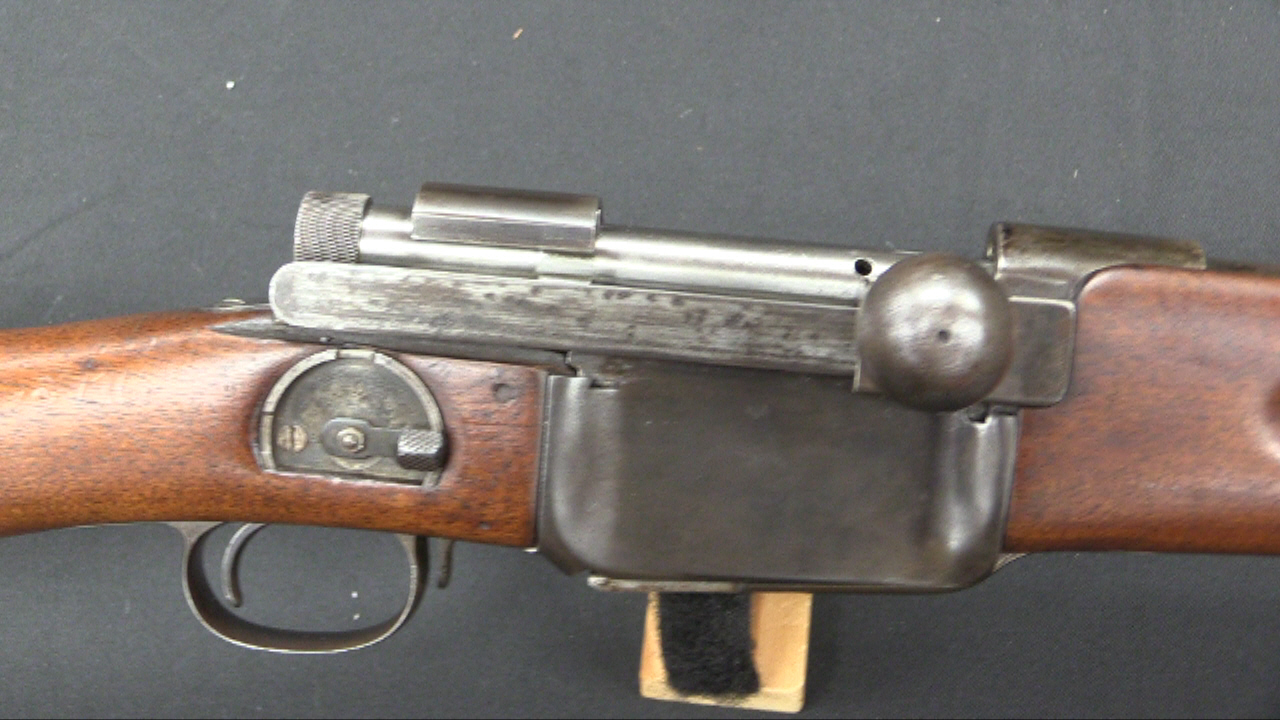
In 1919 it was a little behind the times in still being a pistol-caliber weapon, when it had been accepted that rifle-caliber guns were needed to do serious damage even to the relatively frail aircraft of the day.
However, it would probably have wowed American police departments a few years later when the “gangster wave” broke over America for a year and a half. Mounted on a police motorcycle sidecar, it would have made for sensational press releases if nothing else.
The caliber would probably have been changed to .45 ACP, but the 7.65mm P would have had better penetration on auto coachwork while reducing the chances of over-penetration compared to, say, a Colt Monitor (BAR) in .30-06.
cheers
eon
Well, let’s see here. A couple of cops with a sidecar mounted double-barrel SMG set against two sedans full of gangsters likely armed with revolvers and a semi-auto hand guns, as Thompsons were a bit too expensive for most moon-shining criminals. The cops would probably win after spraying both cars.
OTOH, several of the MidWest’s and Plains states gangsters (such as Dillinger, his buddies the Bowman brothers, and Clyde Barrow & Co.) had an atavistic fondness for stealing BAR’s from National Guard armories.
Contrary to Hollywood (I’m looking at YOU, Warren Beatty), Barrow never used a Thompson. Due to his short stature (5’4″), he preferred a BAR with the stock cut to 8″ and the barrel cut off just ahead of the end of the gas tube with the front sight ring reattached, sans flash hider.
My late mother “met” Dillinger and the Bowmans coming out of the general store in Pomeroy, OH, one day about six months before Dillinger bought it at the Biograph. They’d stopped because one of the Bowman boys wanted a bottle of pop, and being who they were, they couldn’t resist emptying the till while they were at it. (They didn’t pay for the bottle of pop, either.)
She knew guns. (Who do you think I first learned it from?) She was an auxiliary deputy sheriff, and a bail-bond skip-tracer. She said definitely that Dillinger had a .38 Colt automatic (Sporting Model), the Bowmans had .38 revolvers (one Colt, one S&W), and the guy in the car sitting in the right rear covering their egress had a chopped BAR, not a Thompson.
A .30-06 BAR firing at a rate of about 500 R/M from a 20-shot box magazine tended to make a mess out of any sedan on the road back then. Now you know why chasing bank robbers wasn’t exactly a highly sought-after vocation.
And since the BARs were stolen, they didn’t cost the gangsters one red cent. In fact, if they’d been able to buy them legally (and before the NFA 1934, the Colt Monitor could be bought just like any other rifle), they’d probably still have stolen them. It was the principle of the thing.
Just like that bottle of pop. And the money in the till.
cheers
eon
Why not just give Cops of the twenties era ARMORED CARS!?
Money and weight. Not only were armored-up vehicles expensive, but the extra weight seriously degraded their performance, due to their relatively low horsepower, which made them questionable as pursuit vehicles.
Contrary to popular belief, the “hot cars” of the prewar period weren’t all that “hot”. Their sizes and the sheer mass of their engines might have looked impressive, but they were fairly low compression, and even with supercharging they didn’t really have that much “get up and go” by even 1950s standards.
Some stats courtesy of American antique car expert Tad Burness’ books;
1925 Ford Model T; 4 cyl, 176.7 CID (2.8L), 20 HP
1927 Dodge “Fast Four”: 4 cyl L-head, 212.3 CID (3.4L), 40 HP@2400 revs, max speed 60 MPH (~100 KPH)
1928 Cadillac (Capone’s favorite): V-8, 341 CID (5.6L), 90 HP, all-up wt. 5135 lbs/ 2,334 kg
1927-30 Lincoln (Locke body, tourers, roadsters, etc); V-8, 384.8 CID (6.3L), 90 HP @ 2800 revs, top speed ~75 MPH (120 KPH)
A little later displacement and HP went up a bit;
1933 Duesenberg; Lycoming (aircraft-type!) straight-8, 420 CID (6.9L), 265 HP @ 4250 revs, max speed ~130 MPH (200 KPH+)
1933 Hudson (a favorite “cop car” of the post-gangster era): Straight-8, 254.1 CID (4.17 L), 7:1 compression ratio on “police specific” engine, 101 HP @ 3600 revs, 3650 lbs (1660 kg) all up, top speed ~125 MPH (~200 KPH even)
And oh yes, the vaunted
1937 Mercedes Benz 540K: (5.4L, with “Kompressor”[supercharger]); 330 CID, 180 HP with the blower on, 115 HP in normal aspiration, all-up weight 5800 lbs (2637 kg!),top speed ~120 MPH
So you see, by the time relatively “hot” cars arrived on the scene, the “gangster era” was over and done.
And twenty years later, any kid with a hot-rodded Model T with a (at the time) modern small-block V-8 in it could outrun the hottest cars of the prewar period.
The between-the-wars cars here and in Europe were certainly elegant and comfortable. Some were even moderately easy to drive.
Light, they were not, even without armor. And fast, not so much at all, armored or otherwise.
cheers
eon
The double mounting with top magazines looks a lot like the contemporary Villar-Perosa. I think those ended up on motorcycle sidecars.
Fascinating.
I have never encountered a dingle barreled firearm.
Dingle Berries, yes, dingle barrels, no.
Tom beat me to the punchline about the ‘Dingle barreled’ comment 😉 I have been referred to as ‘Dingle Brained’ on a few occasions though! Perhaps I could have designed it 😉
I have handled the various models of Villar-Perosa guns (double & single barreled) in the Beretta collection at the factory in Gardone-val-Trompia and they are beautifully engineered guns (especially the double mount). I have even fired a few rounds out of a single barreled sub-gun variant and thought it a smooth firing action…
When you get into the Leeds collection, make sure to check out the Villar-Perosa in .455… 🙂
Holy (expletive deleted). That would be “pushing the envelope” for such a design. Sort of like chambering it for .45 Colt or .44 Special. (!)
IIRC, when Sheppard & Turpin first proposed their “machine carbine” aka the Sten MK I, didn’t Ministry of Supply “suggest” that it be chambered for .380in Revolver aka .38 S&W? Due to the .32 ACP not being considered powerful enough, .38 Automatic ammunition being in short supply, and all .45 ACP having to come from the U.S. via Lend Lease.
Of course, they came back by pointing out that Alexander & Co., Ltd. had captured all that Italian hardware in North Africa, including several million rounds of 9 x 19mm loaded for the Beretta M1938 (very hot load, “+P” or maybe “+P+” by modern standards).
And since the 9mm obviously worked perfectly well in everybody else’s machine carbines, it would make good sense not to let it go to waste.
Still, post-war, Colt did come up with a Gold Cup in .38 Special Mid-Range Wadcutter, and S&W replied with the Model 52 Master in the same caliber. So just about anything is possible in this department.
“Smart” is another mater entirely when designing a weapon for combat rather than the target range. A TOZ-35 Vostok free pistol would be great for Olympic slow-fire 50 meter; its usefulness in an actual gunfight after the first shot is debatable.
(I.E., don’t miss.)
cheers
eon
The Hammerli P 240 is chambered in .38 wadcutter as well. I shot one in Aruba of all places, and wouldn’t hesitate to carry it in a gunfight. Those flat lead bullets would probably make some ugly wounds.
Regarding the STEN,IIRC Owen had the same problem in Australia, as the army wanted him to rechamber his SMG in .38-200 S&W for testing (supposedly to make it purposefully unreliable as they were pushing for the adoption of the AUSTEN).
I’d love to be able to mount a Villar-Perosa on the sidecar of my wife’s Vespa if I could ever get my hands on a transferable one. It would be fun, but I still wouldn’t want to be seen riding it! 🙂
Okay, that last idea seems sillier than riding a motorcycle with a Breda 30 mounted on the handlebar.
CD;
Not any crazier than an MG34 on the sidecar of a BMW R75. And the Wehrmacht did that as SOP.
“Crazy” would be a .50 Browning on the sidecar. About three bursts and if the gun mount held, there’s a good chance the sidecar would part company with the bike.
cheers
eon
The Italian Bersaglieri with the Breda 30 mounted on the handlebar were a logical consequence of the Bersaglieri as reconnaissance and screening infantry. The mission of the motorcycle Bersaglieri was very similar to the traditional mission of horse cavalry, not surprising considering that the Bersaglieri were originally established the augment the very small cavalry of Piedmontese army. The gun could be removed fairly easily and used dismounted if necessary. It was mounted in order to provide quick fire support on contact with the enemy or to cover a retreat.
Hi Ian, OK, will do! I’ll ask Trevor if I can ‘play’ with it…
I have a photo of the .455 Villar-Perosa here, if anybody wishes to check it out.
http://i.imgur.com/VdCyFaB.png
It was tested in 1916 but nothing came of it, much like every subsequent SMG that was submitted to the Small Arms Committee before WWII…
There was the 9mm SerLea submachine gun with double barrels and fed from 30 round magazines. It used a synchronising device to increase the ROF to 3000rpm.
AugFC, i have enjoyed your articles on unusual firearms.
Thanks! I’ll keep them coming.
On the subject of the SerLea, it was certainly an interesting design but the only action it ever saw was in a b-rate action movie – far too impractical for modern combat. If it’d been made during the prohibition era, it might’ve been a different story…
I’m not sure if it actually ever got beyond the blank-firing mock-up stage, to be honest. Someone ought to get in touch with ACE and ask about it.
Hello Ian
The gun was called the ‘Fliegerdoppelpistole 19’ (roughly airplane double pistol 19), used as an observer gun in a couple of Swiss Airplanes after the 1st WW. There were 61 produced in total. Magazine capacity was 50 rounds per mag, cadence was 1100 r/m per barrel which emptied the magazines pretty fast me thinks and weight was 9 kg which was an advantage over MG’s in those days but of course it was superseded by MG’s soon after.
Adolf Furrer was Director of Eidgenössische Waffenfabrik from 1921-1940, having been responsible for above weapon, plus an aircraft machine gun in single and double versions with a cadence of 1300 r/m in 1929 (!), the mentioned LMG 1925, the most expensive and complicated MP ever made and, believe it or not, the toggle locked 34 mm watercooled anti aircraft gun which was in Swiss Army Service until the 60tis. He was really taken with the toggle lock indeed! As with all Swiss army guns to this day: Superbly made, rather heavy, extremely accurate but probably wouldn’t pass the test of war. But of course we never had to do that. I lugged the Stgw 57 (SIG 57)in 7.5 Swiss around quite some time and as the saying went: if you saw it, you hit it, out to 600 metres or more. Even on auto quite accurate.
Keep the good stuff up! Regards from Switzerland!
Thanks for the information, Peter!
Thinking about the Gast gun principle, if this had one recoil booster, and a staggered action, when one fired it would cock the other toggle “via a link” it would then fire during the rearward motion of the first, but a return spring would push both forward, then the first would fire again then etc is that right?